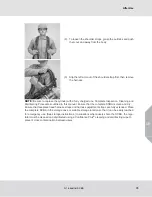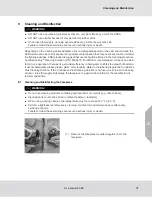
40
Cylinders
G1 Industrial SCBA
US
10 Cylinders
10.1 Safety Precautions for MSA Self-Contained Breathing Apparatus Cylinders
WARNING!
To maintain NIOSH approval, the cylinder must be fully charged with respirable air meeting the
requirements of the Compressed Gas Association specification G-7.1 1989 for Quality Verification
Level (grade) D air or equivalent specification. In fire service applications, MSA recommends
breathing air quality in accordance with NFPA 1989.
DO NOT drop the cylinder or bump the valve knob. An unsecured cylinder can become an airborne
projectile under its own pressure if the valve is opened even slightly.
Never carry or move a cylinder by the handwheel. If a cylinder is removed from a horizontal shelf
by grasping the handwheel, the weight of the cylinder can cause the cylinder to rotate downward
causing the valve to open slightly.
Avoid dropping the cylinder or bumping the handwheel.
Use the handwheel only to open and close the cylinder valve.
A valve could partially open causing the cylinder to become an airborne projectile under its own
pressure and result in serious personal injury or death.
Remove from service if cylinder shows evidence of exposure to high heat or flame: e.g., paint
turned to a brown or black color, decals charred or missing, gauge lens melted, or elastomeric
materials distorted.
Use this device only after receiving proper training in its use. Use in accordance with this label and
MSA apparatus instructions.
Do not use unless the cylinder is filled to the maximum working pressure.
Do not alter, modify, or substitute any components without approval of the manufacturer.
Inspect frequently. Maintain according to manufacturer's instructions. Repair only by properly
trained personnel.
Misuse can result in serious injury or death.
Breathing apparatus cylinders should be fully recharged as soon as possible after use.
Cylinders should not be stored partially charged:
• If used partially charged, the duration of the SCBA is reduced.
• The pressure relief device is only designed to protect a fully charged cylinder from the effects of a
fire.
For maximum safety, the cylinders should be stored full or at a pressure above ambient but less than
100 psi.
Prior to recharging, cylinders must be examined externally for evidence of high heat exposure, corro-
sion, or other evidence of significant damage.
Additional information of value when performing external and internal inspections of cylinders may be
found in the latest editions of CGA Publication C-6.2: “Guidelines for Visual Inspection and Requalifi-
cation of Fiber Reinforced High Pressure Cylinders” available from the Compressed Gas Association,
Inc., 1725 Jefferson Davis Highway, Suite 1004, Arlington, VA 22202-4102.
If there is any doubt about the suitability of the cylinder for recharge, it should be returned to a certified
hydrostatic test facility for expert examination and testing.









































